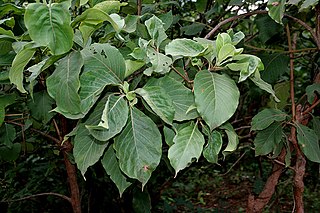
Uncaria is a genus of flowering plants in the family Rubiaceae. It has about 40 species. Their distribution is pantropical, with most species native to tropical Asia, three from Africa and the Mediterranean and two from the neotropics. They are known colloquially as gambier, cat's claw or uña de gato. The latter two names are shared with several other plants. The type species for the genus is Uncaria guianensis.

Robert Fortune was a Scottish botanist, plant hunter and traveller, best known for introducing around 250 new ornamental plants, mainly from China, but also Japan, into the gardens of Britain, Australia, and the USA. He also played a role in the development of the tea industry in India in the 19th century.

Urtica is a genus of flowering plants in the family Urticaceae. Many species have stinging hairs and may be called nettles or stinging nettles. The generic name Urtica derives from the Latin for 'sting'.

Clintonia is a genus of flowering plants in the lily family Liliaceae. Plants of the genus are distributed across the temperate regions of North America and eastern Asia, in the mesic understory of deciduous or coniferous forests. The genus, first described by Constantine Samuel Rafinesque in 1818, was named for DeWitt Clinton (1769–1828), a naturalist and politician from the U.S. state of New York. For this reason, plants of the genus are commonly known as Clinton's lily. The common name bluebead refer to the distinctive fruit of members of the genus. Since fruit color varies somewhat across species, the common name bead lily is used as well.

Nyctanthes arbor-tristis is a species of Nyctanthes native to South Asia and Southeast Asia. It is commonly known as night-blooming jasmine, tree of sadness, tree of sorrow, coral jasmine and in Singapore seri gading. Despite its common name, the species is not a "true jasmine" and not of the genus Jasminum.

Morinda is a genus of flowering plants in the madder family, Rubiaceae. The generic name is derived from the Latin words morus "mulberry", from the appearance of the fruits, and indica, meaning "of India".

Centranthera is a genus of plants in the family Orobanchaceae. The genus is distributed in Asia. There are about 10 species in this genus, and the majority have funnel-shaped flowers. In Nepal, Centranthera cochinchinensis is reportedly used an alternate fodder.

Russelia is a genus of flowering plants in the plantain family, Plantaginaceae. It is sometimes placed in the families Scrophulariaceae or Veronicaceae. The name honours Scottish naturalist Alexander Russell (1715–1768). Members of the genus are commonly known as firecracker plants or coralblows. Russelia species grow in many parts of the world and are mildly drought resistant.

Mentha arvensis, the corn mint, field mint, or wild mint, is a species of flowering plant in the mint family Lamiaceae. It has a circumboreal distribution, being native to the temperate regions of Europe and western and central Asia, east to the Himalaya and eastern Siberia, and North America. Mentha canadensis, the related species, is also included in Mentha arvensis by some authors as two varieties, M. arvensis var. glabrata Fernald and M. arvensis var. piperascens Malinv. ex L. H. Bailey.

Gamblea is a genus of plants of the family Araliaceae, comprising four species. It originally comprised a single species, Gamblea ciliata, which is found in India.

I. M. Johnston, was a United States botanist. He studied at Pomona College in Claremont, California and at Harvard University. His plant collections are housed in the Rancho Santa Ana Botanic Garden, in Claremont, and also in the Gray Herbarium of Harvard University.

Pourthiaea is a genus of plants in the rose family (Rosaceae).

Hymenodictyon is a genus of flowering plants in the family Rubiaceae. It has about 30 species. All are native to the Old World. The wood of Hymenodictyon orixense is soft and has limited use, mostly for boxes. The type species for Hymenodictyon is Hymenodictyon orixense.

Perilla is a genus consisting of one major Asiatic crop species Perilla frutescens and a few wild species in nature belonging to the mint family, Lamiaceae. The genus encompasses several distinct varieties of Asian herb, seed, and vegetable crop, including P. frutescens (deulkkae) and P. frutescens var. crispa (shiso). The genus name Perilla is also a frequently employed common name ("perilla"), applicable to all varieties. Perilla varieties are cross-fertile and intra-specific hybridization occurs naturally. Some varieties are considered invasive.

Japanobotrychum is a genus of ferns in the family Ophioglossaceae with the sole species Japanobotrychum lanuginosum. The genus is accepted in the Pteridophyte Phylogeny Group classification of 2016, but not by some other sources.

Catabrosa aquatica, called brookgrass, water whorl-grass, water whirlgrass and water hairgrass, is a widespread species of semi-aquatic grass in the genus Catabrosa, native to the most of the non-tropical northern hemisphere, and to southern Chile and Argentina. As its scientific and common names suggest, it prefers to grow in wet areas, such as meadows, stream banks and lake shores.
Ellisiophyllum is a monotypic genus of flowering plants belonging to the family Plantaginaceae. It contains a single species, Ellisiophyllum pinnatum(Wall. ex Benth.) Makino
Sibbaldianthe is a genus of flowering plants belonging to the family Rosaceae. It is also in the Rosoideae subfamily.
Ivanjohnstonia is a monotypic genus of flowering plants belonging to the family Boraginaceae. The only species is Ivanjohnstonia jaunsariensisKazmi Its native range is the Western Himalaya.
Sohmaea is a genus of flowering plants belonging to the family Fabaceae.
















